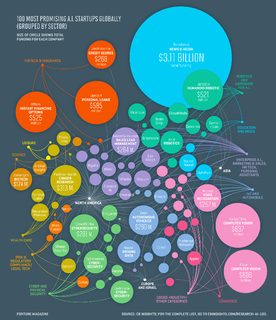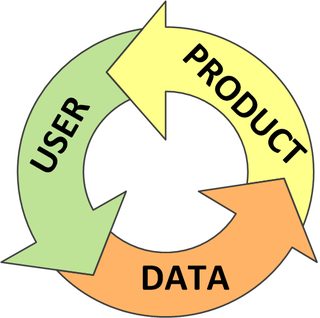Summary: A defensible data strategy increasingly defines those AI businesses that will be successful. VCs know this and are steering the funding to this strategy. Read here about what a defensible data strategy is and how to identify your next AI opportunity using this technique.
 The most recent issue of MIT Technology Review shows their annual list of 35 Innovators Under 35. Of these, 15 are AI-based – 43%. Another 3 are in Computational Synthetic Biology that depends on deep learning.
The most recent issue of MIT Technology Review shows their annual list of 35 Innovators Under 35. Of these, 15 are AI-based – 43%. Another 3 are in Computational Synthetic Biology that depends on deep learning.
Similarly the website Angel.co which tracks the formation and investment in startups shows about 6,800 companies specifically relating to AI. That’s probably understated. I’d round up to an even 10,000.
So it’s no surprise that AI is the siren song that launched 10,000 ships. The real question is how many will survive for even the next three years?
We’re not talking about how existing companies should capitalize on AI to enhance their business. We’re talking about how to become the next Google, Facebook, or Amazon with a lead so dominant that no one can catch up.
What’s the Single Key Strategy that Defines AI Success – Data Dominance
Start to look at individual companies and you’ll see that they are focused on their technology, the user experience, and their product or platform. This perspective will take them no further than being just another product or perhaps only a feature. It will not take them to becoming a long term viable company that will return their investor’s capital, much less the desired multiple.
To create a successful AI company you must create such a wide moat that no one can catch up unless they pay your price. That moat is not about technology. There are essentially no monopolies on deep learning technologies, only leaders that can quickly be copied.
The secret to a wide moat in AI is to have a virtual monopoly on the data you are using to train. In this case monopoly also means such a large lead in users and data volume that no one can reasonably catch up.
How to Create a Data Monopoly
 All AI companies face the same barrier when starting out: how to obtain enough data to train their product.
All AI companies face the same barrier when starting out: how to obtain enough data to train their product.
Everyone recognizes this virtuous feedback cycle, but without users you can’t generate sufficient data, and so it continues.
The question they should be asking, even before taking investment is how the data can be acquired in a way that is strategically defensible. The answer to this question will simply eliminate many markets and applications where data is not defensible or competitors already have substantial leads.
For example, there’s no wide moat available in advertising. Google dominates search-based advertising and Facebook dominates social media based advertising. General e-commerce? Can’t beat the lead that Amazon has in learning about our personal shopping desires. These three industry giants clearly have defensible positions by virtue of their dominant data.
So How Then to Identify and Collect Defensible Data
A defensible data strategy is not something you can sprinkle on any AI startup. It starts by carefully selecting the industry and the problem to be solved. These are not easy to find, but here are some examples to get your thought processes started.
You’ll find here a unique blend of identifying markets and market needs where the addition of AI creates opportunity. You’ll also see examples of creating new types of data in existing markets that competitors can’t duplicate.
Blue River Technology: This is a company that offers agricultural optimization by evaluating each plant individually at each stage of growth. There are plenty of competitors that use drones or stationary sensors to divide a field into smaller segments to be optimized but no competitor that does this on a plant-by-plant basis.
 Their technology platform looks like 30 foot wide arms on the front of a tractor that literally takes an image of each plant (think lettuce for example) as the arm passes over. Based on their AI model the platform makes an AI-driven instantaneous decision to provide water, fertilizer, or to apply an herbicide. No sense putting energy into a plant that’s not going to make it or if it’s a weed. Blue River calls this ‘see and spray’.
Their technology platform looks like 30 foot wide arms on the front of a tractor that literally takes an image of each plant (think lettuce for example) as the arm passes over. Based on their AI model the platform makes an AI-driven instantaneous decision to provide water, fertilizer, or to apply an herbicide. No sense putting energy into a plant that’s not going to make it or if it’s a weed. Blue River calls this ‘see and spray’.
The process of getting the training data wasn’t simple and involved a significant investment in running their prototype platform over farm fields to acquire images of individual plants which were then coded for health, sickness, and optimum use of fertilizer and water. They now have the world’s largest database of plant images which continues to grow with each pass of their equipment over a field. Their lead in plant level AI image training data in unassailable.
Axon: You may recognize Axon by its previous name Taser, the maker of the ubiquitous stun gun favored by law enforcement. We wrote about Axon two years ago when they were making the transformation from hardware to data-driven data science business.
At the time they had expanded to include the wearable body camera devices that are now almost mandatory on police. Two years ago they also realized that police departments would need a place to store this audio and video data and created a cloud storage service that has continued to grow.
A few months ago, they announced that they would provide a free year of video storage to their clients. This was already the largest database of law enforcement action video and audio data available and is now becoming even more dominant.
This provides Axon a completely defensible lead for applications like facial recognition, voice stress analysis, streaming video identification of partially visible weapons, predictive and even prescriptive policing, and a whole host of other AI applications that they can roll out.
Stitch Fix: This is a company that has out maneuvered all its e-commerce fashion competitors by creating data that none of them can ever acquire.
Starting its AI expansion in about 2016, Stitch Fix brings its users a curated fashion offering for both men and women based on the customers’ own stated and incrementally improved fashion desires. The secret sauce is that each customer interacts with a human Stitch Fix fashion consultant who adds a level of specificity and personal taste to the products offered to the buyer.
Originally set up as a subscription service with a monthly shipment of personally curated clothing and accessories, the data obtained based on what was shipped versus actually purchased allowed a level of accuracy in targeting that no competitor could hope to achieve. The feedback loop between customer and personal fashion consultant was critical. It’s this human-in-the-loop data that can’t be duplicated by competitors.
Stitch Fix was an early adopter of deep learning analytics on browsing and buying image data identifying what specific features of each piece of clothing was most attractive. Their business extension was to use this data to create wholly new fashion offerings of their own in-house design to more specifically meet the needs demonstrated by their shoppers augmented by the personal interaction with each in-house fashion consultant and the data that results.
Not all AI business opportunities are created equal. VCs have already caught on to the requirement for a defensible data strategy and are steering their investments this way. Wide data moats aren’t easy to spot but when you find one to pursue, your odds of AI business success are greatly increased.
Other articles on AI Strategy
Comparing the Four Major AI Strategies
Comparing AI Strategies – Systems of Intelligence
Comparing AI Strategies – Vertical versus Horizontal.
AI Strategies – Incremental and Fundamental Improvements
Other articles by Bill Vorhies.
About the author: Bill Vorhies is Editorial Director for Data Science Central and has practiced as a data scientist since 2001. He can be reached at:
